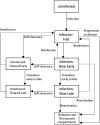Is neglect of self-clearance biasing TB vaccine impact estimates?
- PMID: 37558271
- PMCID: PMC10414120
- DOI: 10.1136/bmjgh-2023-012799
Is neglect of self-clearance biasing TB vaccine impact estimates?
Abstract
Background: Mathematical modelling has been used extensively to estimate the potential impact of new tuberculosis vaccines, with the majority of existing models assuming that individuals with Mycobacterium tuberculosis (Mtb) infection remain at lifelong risk of tuberculosis disease. Recent research provides evidence that self-clearance of Mtb infection may be common, which may affect the potential impact of new vaccines that only take in infected or uninfected individuals. We explored how the inclusion of self-clearance in models of tuberculosis affects the estimates of vaccine impact in China and India.
Methods: For both countries, we calibrated a tuberculosis model to a scenario without self-clearance and to various scenarios with self-clearance. To account for the current uncertainty in self-clearance properties, we varied the rate of self-clearance, and the level of protection against reinfection in self-cleared individuals. We introduced potential new vaccines in 2025, exploring vaccines that work in uninfected or infected individuals only, or that are effective regardless of infection status, and modelling scenarios with different levels of vaccine efficacy in self-cleared individuals. We then estimated the relative disease incidence reduction in 2050 for each vaccine compared with the no vaccination scenario.
Findings: The inclusion of self-clearance increased the estimated relative reductions in incidence in 2050 for vaccines effective only in uninfected individuals, by a maximum of 12% in China and 8% in India. The inclusion of self-clearance increased the estimated impact of vaccines only effective in infected individuals in some scenarios and decreased it in others, by a maximum of 14% in China and 15% in India. As would be expected, the inclusion of self-clearance had minimal impact on estimated reductions in incidence for vaccines that work regardless of infection status.
Interpretations: Our work suggests that the neglect of self-clearance in mathematical models of tuberculosis vaccines does not result in substantially biased estimates of tuberculosis vaccine impact. It may, however, mean that we are slightly underestimating the relative advantages of vaccines that work in uninfected individuals only compared with those that work in infected individuals.
Keywords: Mathematical modelling; Tuberculosis; Vaccines.
© Author(s) (or their employer(s)) 2023. Re-use permitted under CC BY. Published by BMJ.
Conflict of interest statement
Competing interests: None declared.
Figures




Update of
-
Is neglect of self-clearance biassing TB vaccine impact estimates?medRxiv [Preprint]. 2023 May 9:2023.04.11.23288400. doi: 10.1101/2023.04.11.23288400. medRxiv. 2023. Update in: BMJ Glob Health. 2023 Aug;8(8):e012799. doi: 10.1136/bmjgh-2023-012799. PMID: 37090535 Free PMC article. Updated. Preprint.
References
-
- World Health Organization . Global TB report 2022; 2022.
Publication types
MeSH terms
Substances
Grants and funding
LinkOut - more resources
Full Text Sources
Medical
Research Materials
